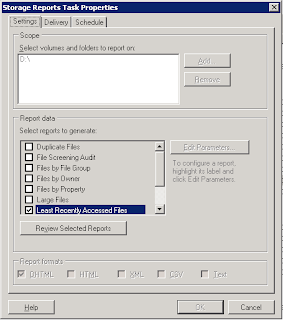First of all , and that is what this part is about, I need to determine if this project makes sense or in other words; How many extra free space is there to achieve and will it be worth the effort....
 A prequisite of this guide is that the File Services role is installed on a server which has access to the volume where the data is stored. For more information about installing the File Server role or the File Server Role check the following link:
A prequisite of this guide is that the File Services role is installed on a server which has access to the volume where the data is stored. For more information about installing the File Server role or the File Server Role check the following link:http://blogs.technet.com/b/josebda/archive/2008/08/20/the-basics-of-windows-server-2008-fsrm-file-server-resource-manager.aspx
With Windows File Server Rescource Manager you can generate a report with Server Manager > Roles > File Services > Share and Storage Management > File Server Rescource Manager > Storage Reports Management.
 You can create your own report by clicking on Schedule a new report task in the Action menu.
You can create your own report by clicking on Schedule a new report task in the Action menu.In the wizard you can define the scope/volume(s) or folder(s) of the report task and the parameter the reports needs to collect data for.
In my case the scope is D:\ and the data is the Least Recently Accessed Files. Click the Edit Parameter button to define the reach of the report, in my case 365 days.( < 1 year not accessed)
Click the schedule tab to define when the report needs to run, once, on a daily base etc.
You can select the Report format and specify an email address in the Delivery tab if the report needs to be mailed when the task is finished.
When the task is configured can run it by selecting the task and by choosing the Run report task now option.
The report is not very detailled(only shows 1000 files, but total of complete scope is in the red rectangle) but will give you the information needed:
This shows that the total size of files matching scope criteria is 1TB. With the volume's size of 2TB and 1,5TB of usage, it is defenitly worth the effort to create a technical solution that will move this data from the SAN to another kind of storage media.
A 'user-friendly' solution would be; immediate accessible on the same location. But how, since the original location is the SAN and the goal is to move it from the SAN.
How this will be achieved will be described in the next article so keep on reading :)


Geen opmerkingen:
Een reactie posten